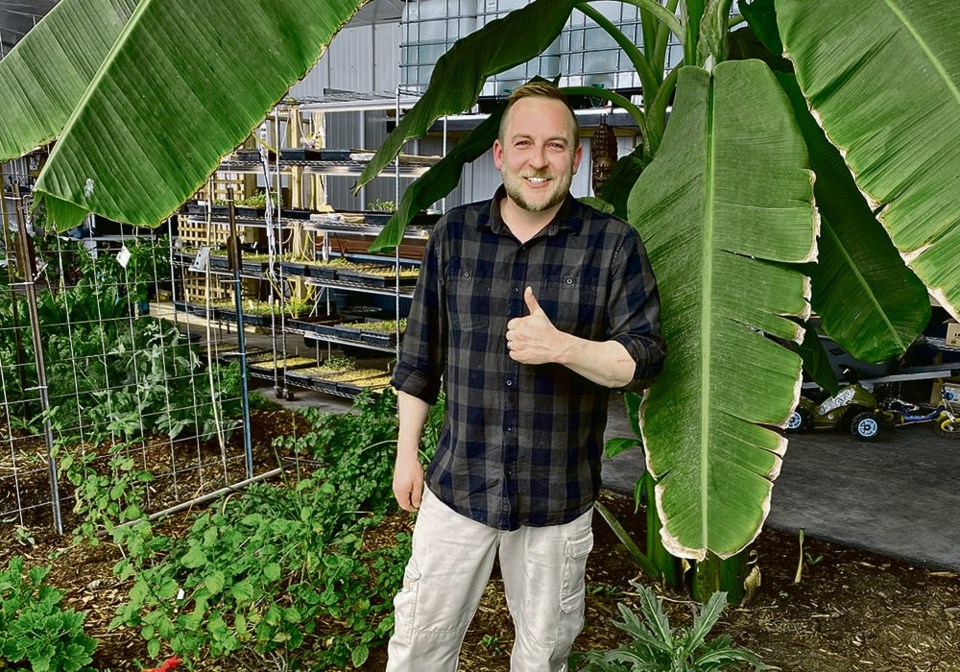WESTERN PRODUCER — A while back, Saskatchewan resident Dean Sopher dreamed of feeding his family a nutritious, year-round diet of meat, eggs, vegetables and fruit, all produced and harvested in the middle of Saskatchewan.
Today, thanks to some innovative technology and plenty of hard work and determination, Sopher’s dream of food self-sufficiency has become a reality on an 80-acre parcel of land just a few kilometres from Saskatoon.
On a cold winter afternoon in mid-March, Sopher is warm and cozy tending fruits and vegetables inside his “deep winter” greenhouse, a building that’s specially designed to collect optimal amounts of solar heat and sunlight during the cold Canadian winters, and regulate the amount of direct sunlight the greenhouse receives during the province’s hot, dry summers.
Inside the building, Sopher and his wife are cultivating oranges, figs, lemons, bananas and other tropical fruits that typically wouldn’t stand a chance in the frigid prairie climate.
Not far away, swiss chard plants are rich and red, lettuce and herbs are ready for harvest and healthy green tomato plants are coming into bloom.
At the back of the greenhouse, water tanks filled with tilapia and brook trout will augment the family’s meat supply, which consists of chickens and goats, and provide natural fertilizers for the greenhouse.
The 3,000 sq. foot greenhouse, says Sopher, requires only a minimal amount of supplemental heat in the winter and is consistently maintained between a low of 10 C and highs in the low- to mid-30s during the coldest winter days.
Walls on the north, west and east sides of the greenhouse have extremely high insulative values, and thermal heat contained in water tanks and concrete floors helps moderate interior temperatures.
“In the winter, our sun is very low so the sunlight comes into the greenhouse very deep, at a low angle, because we’re so far north,” Sopher said.
“At the 14 degree winter solstice, the sun hits everything in the greenhouse. And then, at our summer solstice, the direct sunlight only hits half of the greenhouse. The other half is in the shade.”
Sopher is experimenting to determine which plants are best suited for different areas of the greenhouse.
Those that thrive in maximum sunlight conditions are –°¿∂ ”∆µ situated near the front of the greenhouse, where direct sunlight is available 12 months per year.
Cooler season crops that prefer some shade will be placed near the back of the building.
So far, figs are a big producer. Artichokes are also producing well and the first crop of bananas is a few months away.
“Total annual operating costs for the facility are like $750 a year,” said Sopher, who uses a combination of wood and natural gas in the winter to keep night-time temperatures above 10 C.
In-floor heat, which hasn’t been hooked up yet, could drive those costs even lower, he said.
“We’re figuring things out as we go and we’re passionate about it.”
While Sopher conceded that he is still fine-tuning the operation, he is convinced that the operation will allow him to become nearly fully self-sufficient in food production, with surplus to sell.
Root vegetables will be grown in the outdoor garden each spring while the winter greenhouse will produce fruits, berries, herbs and fish.
“In the greenhouse, we’re able to grow essentially anything that you can’t grow in Saskatchewan,” Sopher said.
“So, tropical fruits, two kinds of bananas, guava, passion fruit, oranges, lemons, limes — figs do really well — artichokes, eucalyptus, ginger….We’re in full vegetation all winter.
“The plants slow down a bit in our coldest months, just because of the reduced daylight. But right now, the days are getting longer because we just had the spring equinox so my wife is planting in full force, starting all the seedlings that are going to go outside eventually.”
Sopher would like to expand production in the greenhouse by introducing elevated growing systems, such a vertical hydroponics.
The goal is to produce a surplus of food and sell food baskets to a small, local client base that holds similar values based on local food production and sustainable, regenerative agriculture systems.
To supplement the family income, Sopher also started an agri-food processing and marketing business called Arkopia.
Arkopia’s core product is a freeze-dried fruit smoothie, sold in food grade pouches and invented by the Sopher family.
Production and packaging of Arkopia smoothies have been outsourced to keep production costs low but the product upholds Sopher values, which stress the importance of food security and producing healthy, high-quality foods sustainably.
Arkopia’s production model also helps to reduce food waste to zero with the freeze-drying process ensuring a nearly infinite shelf life and eliminating the need for refrigeration.
Sopher admitted that building and maintaining the greenhouse has taken a lot of work and dedication.
But he and his wife wouldn’t have it any other way.
On cold winter days, when other families are confined to their homes, the Sophers and their three children spend time in the greenhouse — relaxing, playing in the sunlight or tending their unusual collection of prairie plants.
“We knew we had to get closer to our food supply — both for the quality of food, the availability of food, the freshness of food and to cope with rising food prices,” Sopher said.
“In Canada, the average family of five, like ours, is now spending about $20,000 a year on groceries. That’s on average, and not necessarily eating very healthy either. So an operation like this makes complete economic sense.”
Even without annual food inflation running in the double digits, you can’t put a value on the benefits of producing healthy homegrown food in your own back yard.
“It’s a beautiful life, really,” says Sopher.
“We love it.”




